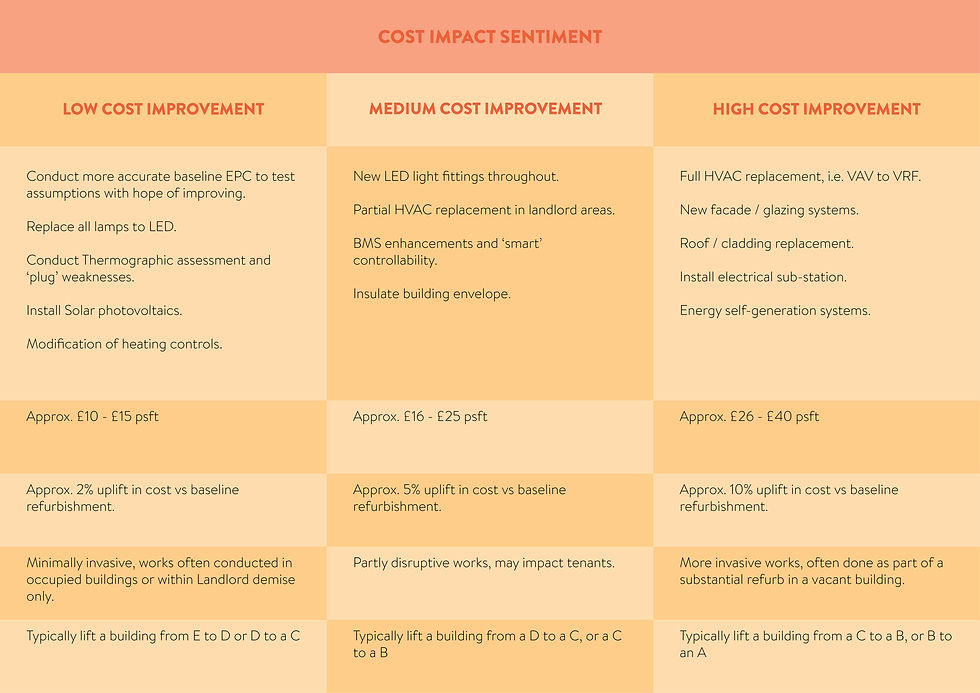How will the UK commercial office market meet the Governments Net Zero Strategy
- WR-AP
- Apr 28, 2023
- 3 min read
Updated: Dec 18, 2023
The UK government's Net Zero Strategy, also known as Build Back Greener, is a plan to achieve net-zero greenhouse gas emissions by 2050. This strategy includes ambitious targets for reducing emissions in all sectors, including the commercial office market. One of the key components of the strategy is the introduction of new Energy Performance Certificate (EPC) targets for 2030. This blog will explore the impact of the Net Zero Strategy and the new EPC targets on the UK commercial office market and provide guidance for landlords and building owners on how to prepare for the upcoming legislation.

Impact of the Net Zero Strategy on the UK Commercial Office Market
The commercial office market is one of the largest contributors to greenhouse gas emissions in the UK. Many will be aware that buildings account for 40% of the UK's carbon emissions, with commercial properties making up a significant portion of that figure. The Net Zero Strategy aims to address this by promoting the adoption of more sustainable building practices and the use of renewable energy sources.
One of the key targets of the Net Zero Strategy is to ensure that all new buildings are net-zero carbon by 2030. This target will have a significant impact on the commercial office market, as new buildings will need to be designed and constructed with sustainability in mind. Building owners and landlords will need to consider the environmental impact of the materials they use, as well as the energy efficiency of the building's design and systems.
The Net Zero Strategy also aims to retrofit existing buildings to improve their energy efficiency and reduce their carbon emissions. This is particularly relevant for the commercial office market, where many buildings were constructed before energy efficiency standards were in place. Retrofitting existing buildings can involve upgrading heating and cooling systems, installing insulation, and implementing renewable energy sources. WR-AP are currently engaged in reviewing a number of existing office buildings for building owners to established how they can be effectively retrofitted to meet future needs.

Impact of the New EPC Targets on the Commercial Office Market
The Energy Performance Certificate (EPC) is a rating system that measures the energy efficiency of buildings. The EPC rating is determined by an assessment of the building's energy use, and ranges from A (most efficient) to G (least efficient). In 2018, the UK government introduced a requirement for all new commercial buildings to achieve an EPC rating of at least E. However, new targets have been set for 2030, which will require all commercial buildings to achieve an EPC rating of at least B. A recently published piece of Savills research shows that at present 85% of office stock in the UK office market is rated an EPC ‘C’ or below, whilst 800 million sq ft is below the proposed minimum EPC ‘B’ rating. Based on the indicative cost modelling that they have undertaken to make the required improvements, it is set to cost UK landlords as much as £63 billion to reach the EPC targets.
Clearly the new EPC targets for 2030 will have a significant impact on the commercial office market. Building owners and landlords will need to invest in energy-efficient upgrades and improvements to ensure that their buildings meet the new targets. This could involve replacing inefficient heating and cooling systems, upgrading insulation, or installing renewable energy sources such as solar panels or wind turbines.
The new EPC targets will also have implications for tenants of commercial office buildings. Tenants will be more likely to seek out energy-efficient buildings, as they are likely to have lower energy bills and be more comfortable to work in. In addition, landlords of commercial office buildings may be required to disclose the building's EPC rating to prospective tenants, which could impact the building's marketability.
Preparing for the New EPC Targets
To prepare for the new EPC targets, building owners and landlords should take a proactive approach. This could involve conducting an energy audit of their building to identify areas for improvement, developing a plan for energy-efficient upgrades, and investing in renewable energy sources where possible. Landlords and building owners should also engage with tenants to promote sustainable practices, such as reducing energy consumption and waste.
There are several options available to building owners and landlords to meet the new EPC targets. These options and indicative costs are summarised in the table below that has been authored by Savills Research team:

If you’d like to find out more about wr-ap’s knowledge and experience in helping building owners review their net zero responsibilities get in touch with our director Sean Weston. sean.weston@wr-ap.com

This blog post has been written by Sean, one of the directors here at WR-AP . Sean's desire to work in an industry that could help people and society in a small way led him to pursue a career in architecture. You can read more about Sean here.
Commentaires